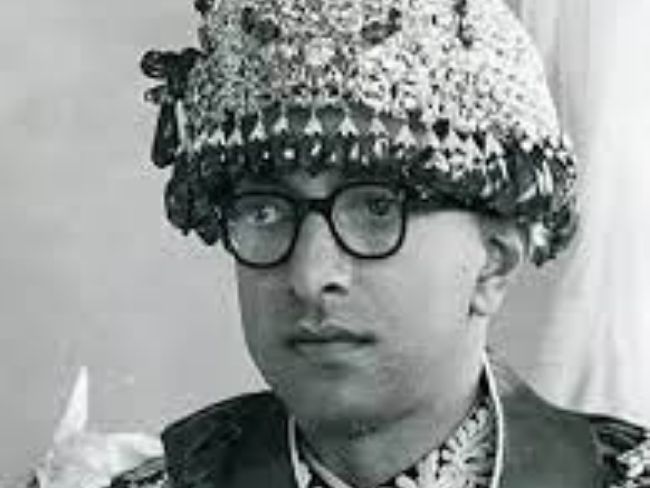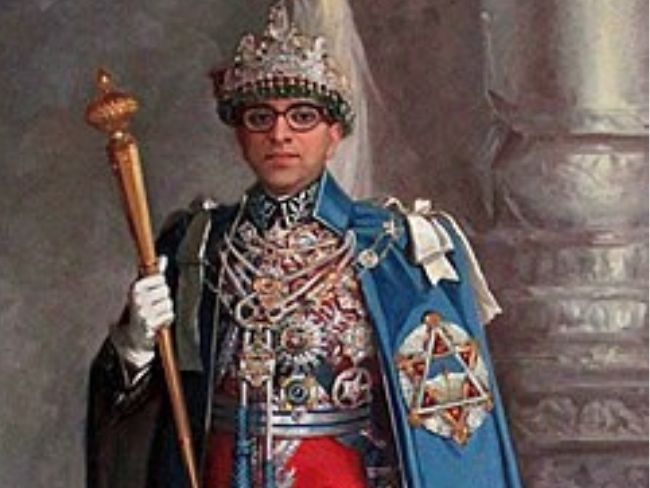King Mahendra Bir Bikram Shah Devwas the ruler of Nepal between 1955 and 1972. He is credited for establishing the Panchayat system, centralizing power, and making significant reforms in education, the development of infrastructure, and administration. His rule marked a turning point in the political history of Nepal, marrying modernization with monarchy.
QUICK FACTS
- Full name: Mahendra Bir Bikram Shah Dev
- BIrthdate : 11 June 1920
- Birthplace: Narayanhity Royal Palace Kathmandu
- Children: King Birendra, King Gyanendra, among others
- Reign: March 13, 1955 – January 31, 1972
- Major Reform: Introduced the Panchayat system in 1962
- Development Works: Started Mahendra Highway, promoted rural development
- Dynasty: Shah Dynasty
- Successor: King Birendra
- Died: January 31, 1972, in Chitwan, Nepal (heart attack)
King Mahendra Early Life
King Mahendra was born on 11 June 1920 (1977 BS) at Narayanhiti Palace in Kathmandu. He was the eldest son of King Tribhuvan and Queen Kanti. During his early years, the royal family lived under the control of the Rana regime, which had reduced the king to a ceremonial role. Although Mahendra did not receive formal schooling, he was privately educated within the palace, where he studied politics, economics, Nepali literature, history, and culture.
In 1940, Mahendra married Indra Rajya Lakshmi, with whom he had six children. After her death in 1950, he married her younger sister, Ratna, in 1952. This marriage caused tension between Mahendra and his father, King Tribhuvan, who disapproved of closer ties with the Rana family. Mahendra became King of Nepal on 13 March 1955, following the death of his father. His formal coronation took place on 2 May 1956, after a year of mourning.
Political Actions & Reforms of King Mahendra
1960 Royal Coup
King Mahendra overthrew Nepal’s first elected government on 15 December 1960, suspended the constitution, and banned political parties. The Prime Minister, B. P. Koirala, and other leaders were arrested. He justified this on the basis that democracy had failed to bring stability and unity.
Panchayat System (1962)
He introduced a new constitution in 1962, which replaced party politics with the partyless Panchayat system. Power was vested in the monarchy, and the government was administered through national and local councils under the monarch’s control.
Land Reforms
King Mahendra initiated land reform programs to limit inequality and help landless peasants. The reforms aimed to break up large estates and distribute land more evenly, though there were many problems in implementation.
Development of Infrastructure
He started the building of the East–West Highway (Mahendra Highway) in 1961. It improved connectivity all over Nepal and stood as a backbone for economic development in the following years.
Rural Development
The Back to the Village Campaign of 1967 encouraged the educated people to work in the rural area. The campaign focused on health, education, agriculture, and local administration, with the aim of upgrading rural life and making it self-sufficient.
Monetary Independence
To attain economic independence, Mahendra opened the Nepal Rastra Bank in 1956. This reduced Nepal’s dependency on the Indian rupee and unified the national economy.
International Diplomacy
King Mahendra led Nepal into the United Nations in 1955 and initiated diplomatic ties with over 60 countries. He followed a non-aligned foreign policy, keeping Nepal neutral in international conflicts like the India-China war.

Major Contribution and Achievements
Contribution to Health
- The first maternity hospital in Nepal, Prasuti Griha, was established in 1959 after the death of King Mahendra’s first wife.
- Kanti Children’s Hospital opened in 1963 with USSR aid; afterwards, child health concentrated.
- Royal Drugs Laboratory (1964) and Nepal Ausadhi Limited (1972) helped in drug research and production.
- Institute of Medicine (1972) started training in health workers under Tribhuvan University.
- Mass eradication of malaria began in 1958 with the assistance of USAID, and then that of smallpox, TB, leprosy, nutrition, and maternal health.
- Several hospitals were built with NGO and mission support in remote and rural areas.
Agricultural Development
- IAAS (1957) was formed to train agri-technicians.
- Birgunj Sugar Mill (1964) and Soktim Tea Estate (1965) boosted agro-industries with foreign support.
- Agriculture Development Bank (1967) and Agriculture Supply Corporation (1965) promoted rural credit and input supply.
- Apple production was promoted in Mustang and Baitadi, and Marpha and Jomsom became apple hubs.
- Timber Corporation (1960) was formed to control forest resources.
- Janakpur Cigarette Factory was formed to reduce tobacco imports.
Tourism Development
- Nepal was opened to world tourism for the very first time during Mahendra’s regime.
- World Tourism Organization in 1959 and created an independent directorate of tourism.
- Established handicrafts, trekking, and hotels; Soaltee and Annapurna Hotels were built in the 1960s.
- Enacted Tourism Act (1964) and Hotel Tax Act (1960) to regulate the industry.
- Popularized Rara Lake by his poem “Rara Ki Apsara” in 1964.
- Established Nepal Tourism Board (1969) and Nepal Academy of Tourism (1972).
- Drove the UN-funded development of Lumbini and cultural tourism.
- Promoted trekking, casino, and hippie trail tourism, which increased Nepal’s international reputation.
Transportation Development
- Before the time of Mahendra, people had to travel via India to reach one Nepali district from another. King Mahendra initiated the Mahendra Highway (East-West Highway) with foreign assistance:
- Foundation stone laid in Gaindakot in 1961.
- The highway played a great role in the socio-economic development of Nepal.
- Built the Kodari Road Link (Araniko Highway) to Tibet, China.
Other Important Highways
- Tribhuvan Rajpath (Hetauda to Thankot) built with Indian help.
- Prithvi Highway (Naubise to Pokhara) began in 1967 (2024 BS).
- Kanti Highway (Lalitpur to Hetauda, 92 km) began in 1954.
Ropeway and Bus Services
- Kathmandu-Hetauda Ropeway built in 1964 with the help of USAID to reduce transportation expenses.
- Sajha Yatayat was established in 1961 for affordable and public transport.
“One-Country, One-monarch, One-language, One-dress”
Mahendra’s endeavour to make the multi-ethnic country into a unitary culture has been under strict criticism from the progressives. The system recognized the identity of the country with Nepali as the language, Daura-Suruwal as national dress and Hinduism as the national religion. Everyone had to wear a Dhaka topi for official purposes: to get their citizenship, passport, and driving license. It was criticized to be unilateral because it dominated a nation with pluralism and completely ignored the existence of the different minority groups in the nation. This policy was promoted in the Nepali language books titled as ‘Mahendramala’ during the period of Panchayat.
Personality
Historians describe Mahendra as ambitious king.[283][284] He was visionary and courageous who would never be afraid in taking any steps.[285] Swiss scholar, Toni Hagen described him as very cunning ruler who could handle delicate issues.[286][287] He was a great admirer of Nepalese literature, paintings and culture which encouraged him to compose many poems which used to be sung by many popular singers. He was proficient in Nepali, English, Hindi and Sanskrit.
End of Reign and Transfer of Power
King Mahendra suffered a massive second heart attack during a winter hunting trip in Chitwan, where he was treated by his personal physicians, Dr. Mrigendra Raj Pandey and Dr. Sachey Kumar Pahari. Initially stable but in critical condition, he passed away at Diyalo Bangala, the royal palace at Bharatpur, on 31 January 1972. His body was transported by helicopter to Kathmandu where he was cremated with state honors. Following his death, his son Birendra aged 26 took over the Nepalese throne at once. However, his coronation was later held on 24 February 1975 at the age of 29 since astrologers had determined that day to be most auspicious under Hindu rituals.
Conclusion
King Mahendra remains a contentious and influential figure in Nepalese history. His reign created a revolutionary change in the political scenario of the nation, including the implementation of the partyless Panchayat system that vested more power in the hands of the monarchy. Despite being credited with developing nationalism, infrastructure, and modernization, his rule also came under fire for muzzling democratic opposition and civil rights. Despite all the scandals, Mahendra’s rule made its mark, determining Nepal’s destiny for centuries to come. His death in 1972 marked the end of an era and opened the way for a new beginning under his son, King Birendra.
You May Also Like:
King Birendra: Legacy of Love and Leadership
Abdulaziz Al Saud: The Strategic Mind that Shaped a Kingdom


Comments are closed